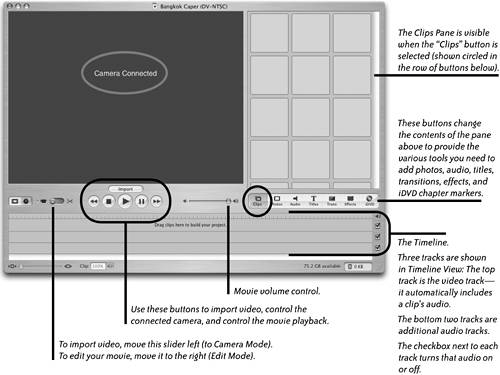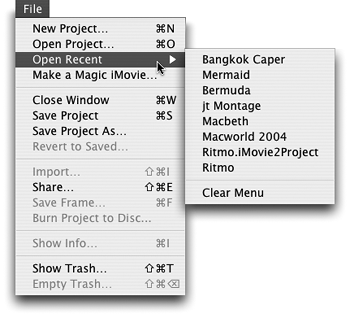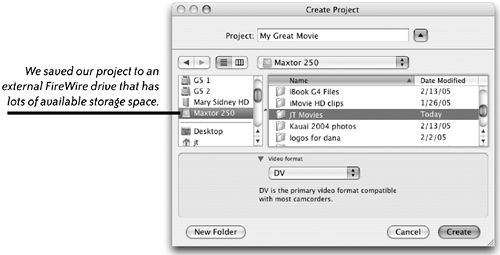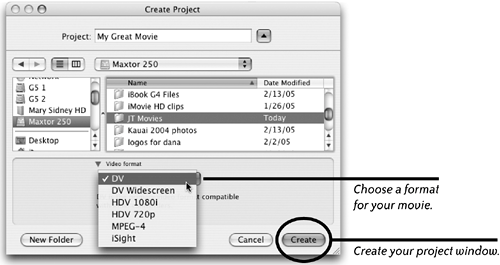| Making an iMovie consists of five basic steps. This chapter walks you through each step. Of course, you must first shoot some video! Keep in mind that when you shoot video, every time you start and stop the camera, iMovie interprets that as a separate movie "clip." You will be able to rearrange those clips to create a simple storyboard (a visual outline) for your movie. Once you've got footage, these are the five basic steps you will follow: 1. | Connect a camera, open an iMovie project window, and import the video.
| 2. | Edit the clips.
| 3. | Add clips to the Timeline.
| 4. | Add enhancements (transitions, titles, effects, chapter markers, etc).
| 5. | Save and share the movie in various formats.
|
 Connect a video camera Before you can import video footage, you must connect your digital video camera to your Mac. If possible, it's best to connect the video camera's AC adapter for power while you import video footage to preserve the camera's battery power. Insert a video tape in the camera that has footage on it you want to import. | A video camera FireWire cable usually is a "4-6 pin" cable with a 4-pin connector on one end and a 6-pin connector on the other end. |
To connect your camera 1. | Plug the 4-pin connector end of a FireWire cable into the camera's FireWire port and then plug the 6-pin connector end into your computer's FireWire port.
| 2. | Set your video camera to "VTR" (Video Tape Recorder) or "Play" mode (do not set the camera to "Record").
| 3. | Open iMovie, if it's not already open.
| 4. | Turn on the camera. After several seconds the words "Camera Connected" appear in the Monitor area, as shown below.
|
 Create a new iMovie project 1. | Open iMovie. The project selection window opens. Choose "Create a New Project" (unless you want to open a project you've already been working on, in which case click "Open an Existing Project")
 If iMovie is already open, you won't see the project selection window shown above. Instead, go to the File menu and choose "New Project…" to open the "Create Project" window (shown below). If iMovie is already open, you won't see the project selection window shown above. Instead, go to the File menu and choose "New Project…" to open the "Create Project" window (shown below).

If you've already created a project, choose "Open Project…." Find and select the project you want to open. Or choose "Open Recent," then select a project you've opened recently (shown on the left).
| 2. | In the "Create Project" window (shown below), name your project and choose the location where you want to save it. Be sure to choose a drive or partition that has plenty of unused disk space! If you make lots of movies, consider buying an external FireWire drive to use just for movie projects. Do not click "Create" yet!
 | 3. | From the "Video format" pop-up menu, choose a video format to use:
DV (Digital Video) is the format most video cameras use. This standard video format, the same proportion that standard TV uses, has an "aspect ratio" (proportion) of 4:3. This is most likely the format you should choose for your movie.
DV Widescreen is the same format as DV, but it uses the widescreen aspect ratio of 16:9. Some video cameras have a setting that shoots in the 16:9 aspect ratio. If your video was shot using a widescreen setting, choose this format for your movie.
HDV 1080i is High Definition Video that uses a vertical screen resolution of 1,080 interlaced scan lines. The horizontal scan lines that make up an interlaced image are divided into even and odd scan lines. Any given instant in the video actually displays only half of the imageeither the even scan lines or the odd scan lines. Choose HDV 1080i only if your video camera shoots in this format.
Which is better HDV 1080i or HDV 720p? 1080i has higher resolution (more vertical scan lines), but its interlaced video is lower quality than progressive video. 720p has lower resolution (fewer vertical scan lines), but its progressive video is better quality than interlaced video. The result is that the two technologies are comparable in quality. |
HDV 720p is a competing High Definition Video format that uses a vertical screen resolution of 720 progressive scan lines. There are fewer scan lines, but any given instant in the video displays both even and odd scan lines (referred to as progressive). Choose HDV 720p only if your video camera shoots in this format.
MPEG-4 is a highly compressed video format used by many consumer video devices, such as a digital still camera. If your video footage comes from a camera that used MPEG-4 format, choose it here.
iSight is a video format compatible with the Apple iSight video camera. Choose this format if you plan to make a movie using video clips captured with an iSight camera.
| 4. | Click the "Create" button to open a new, empty iMovie window.
|
 Preview the video footage in your camera 1. | In the iMovie window, click the Camera mode button.
Tip Don't forget to rewind the tape in your camera before you preview it.If the Monitor shows only a blue screen, you're looking at the unrecorded tape that comes after your last recorded scene. |
| 2. | Click the "Play" button (shown on the left) to view the video from the camera in iMovie's Monitor.
At this point you are just previewing the video. iMovie does not digitize and import any video until you click the "Import" button. Use the controls below the "Import" button to control the camera. Rewind, pause, play, stop, and fast-forward to preview specific scenes.
|
 Import video footage into iMovie 1. | Click the "Play" button to preview the video footage in your camera.
| 2. | When you see the scene you want to import, click the "Import" button (shown above). The "Import" button turns blue when it is selected and importing files.
| 3. | To stop importing, click the "Import" button again. Each time you start and stop importing, iMovie places that segment of video, called a "clip," into one of the square slots in the Clips Pane.
If you have plenty of disk space, you can just let the camera run. iMovie will detect scene changes, import the individual scenes as separate clips, and place each one in the Clips Pane. If you need to conserve disk space, preview the entire tape and import only the scenes you definitely want to use in your movie. Of course you can always delete a clip after it's imported (see the next page).
|
To recover a clip from the Trash, drag it from the "iMovie Trash" window to the Clips Pane.  Delete clips and empty the Trash To delete a clip, select a clip in the Clips Pane (or in the Timeline), then hit the Delete key. Or Control-click on a clip, then choose "Clear" from the contextual menu. As you delete unwanted clips, the number in the Trash pane gets larger, indicating that the deleted clips are going into the Trash. Clips in the Trash take up disk space. To free up valuable disk space, you need to empty the Trash often: Click the Trash icon to open the "iMovie Trash" window. In this window you can play a clip's preview to make sure the clip is not important. You can select just the clips you want to delete, then click "Delete Selected Clips…." Or click the "Empty Trash…" button to delete all clips in the Trash. Import live video with a video camera Press on the camera icon to see the name of the connected camera. If more than one camera is connected, choose the one you want to use from this pop-up menu. 
You can import live video (without first recording it to tape) into iMovie with any compatible digital video camera, even an iSight camera. 1. | Connect the video camera to your computer with a FireWire cable.
| 2. | Set the video camera to "Camera" or "Record" (not "VTR" or "Play").
| 3. | Put iMovie in Camera Mode (shown on the left).
| 4. | Click the "Import" button in the iMovie window.
|
If you're using an iSight camera and can't get iMovie to recognize it, go to iChat's "Video" preferences, disable the option to "Automatically open iChat when camera is turned on," then quit iChat. The "Import" button in iMovie changes to "Record with iSight." |





 If iMovie is already open, you won't see the project selection window shown above. Instead, go to the File menu and choose "New Project…" to open the "Create Project" window (shown below).
If iMovie is already open, you won't see the project selection window shown above. Instead, go to the File menu and choose "New Project…" to open the "Create Project" window (shown below).

